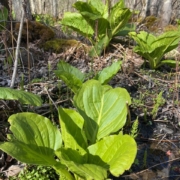April, Part 2
After a year of Covid disorientation came an April of disorder. Hot, dry, then snow on the daffodils. But remember – April is often like that.
An unusually large number of mourning cloak butterflies this year, it seemed to me. Also, other members of the Nymphalidae family that overwinter as adults, such as the delicate Compton tortoiseshell. And song sparrows everywhere. The songs of these cute little birds vary, but most begin with two to five long notes, followed by a string of gibberish.
Perhaps inspired by a year of social distancing, I took to studying the way that flocking birds space themselves. Robins in fields tend to stay four or five feet apart. Juncos, at a bit more than half the size of robins, keep about 18 inches apart. Does this suggest a feeding area that a given bird can expect to exploit? Or could it have to do with predators? Or basic bird hygiene? They all seem to know the rules.
Meanwhile, barring a huge snowfall, the end of April features a lot of false hellebore – the big plants that turn the moist edges of fields and swamps a vibrant green. Many trees – silver maples, red maples, and willows – have finished flowering and wild bees and honey bees will need to find pollen elsewhere, among the march marigolds perhaps or the sugar maples.
Gathering wild leeks for dinner provides a chance to listen to kingfishers rattling, grouse drumming, phoebes singing (yes, technically it is a song), peepers peeping, and wood frogs imitating ducks.



 Mark Isselhardt, UVM Extension
Mark Isselhardt, UVM Extension